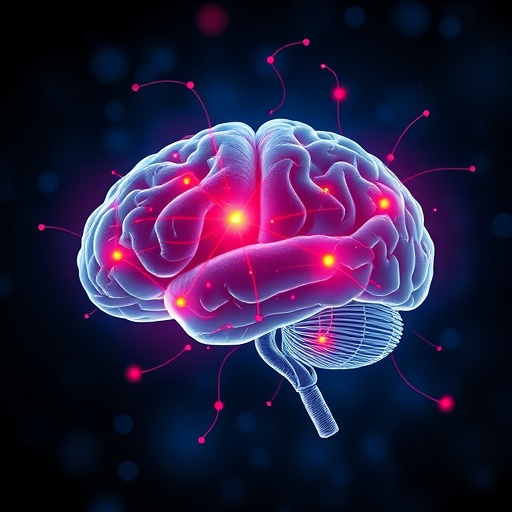In a groundbreaking new study published in Nature Communications, researchers have unveiled compelling evidence that the relationship between stress-related neural activity and mortality is profoundly influenced by age. This discovery sheds new light on the intricate ways our brains respond to stress throughout the human lifespan and how these responses can impact longevity. The study, led by Mikail et al., represents a significant step forward in understanding the neurobiology of stress and its broader implications for health and aging.
Stress is a ubiquitous part of modern life, recognized as a critical factor that affects both mental and physical health. Until now, however, the precise pathways linking stress-induced changes in brain function to mortality risks were poorly understood. This study addresses this gap by exploring how brain activity related to stress varies with age and how these variations are predictive of survival outcomes. The researchers utilized an interdisciplinary approach, combining advanced neuroimaging techniques with longitudinal health data to achieve unprecedented insight.
Central to the study’s findings is the observation that neural markers of stress do not have a uniform effect across all age groups. Instead, age appears to modulate the strength and nature of the connection between the brain’s stress responses and mortality. Younger individuals displaying heightened stress-related neural activity did not show the same mortality risk as observed in older adults with similar neural patterns. This suggests a complex, dynamic interplay where aging may amplify or alter the consequences of stress on vital biological systems.
The methodology employed in the research combined functional magnetic resonance imaging (fMRI) to quantify stress-reactive brain regions with a large-scale cohort study following participants over several years. By tracking clinical outcomes alongside neural data, the researchers could correlate specific patterns of brain activation during stress processing tasks with subsequent mortality rates. This innovative approach allowed for the mapping of neurobehavioral markers to real-world health consequences with a temporal dimension rarely captured in previous studies.
Among the brain areas implicated in the stress response, the amygdala—a key player in emotional regulation and response to threats—stood out as a crucial hub. Increased amygdala activity in response to stress was linked to elevated mortality risk in older adults. This heightened activity is thought to reflect an over-engagement of stress circuits that might contribute to chronic physiological wear and tear, known as allostatic load. For younger adults, similarly elevated amygdala responses did not translate into increased mortality, highlighting the role of age-related factors in mediating these effects.
Furthermore, the study explored the role of the prefrontal cortex, which typically functions to regulate and dampen the amygdala’s response to stress. Age-related decline in prefrontal regulatory mechanisms could exacerbate the impact of stress-induced amygdala activity, compounding its detrimental effects on health. This neural trajectory underpins the importance of brain network interactions in shaping resilience or vulnerability to stress, particularly as the brain ages.
The implications of these findings extend beyond neuroscience into public health and preventive medicine. Understanding how stress-related brain activity evolves with age can inform targeted interventions designed to mitigate risks associated with chronic stress and its downstream effects on mortality. Personalized strategies could be devised, focusing on bolstering neural resilience among older populations, potentially through cognitive training or pharmacological means aimed at enhancing prefrontal control over emotional circuits.
This research also invites a reevaluation of current stress-management protocols. Typically, approaches are generalized without consideration of age-specific neural and physiological contexts. By incorporating an age-modulated framework, clinicians and policymakers might develop more effective, tailored interventions that recognize the shifting neurobiological landscape across the lifespan.
The investigators also highlight important avenues for future research. For example, longitudinal studies that incorporate repeated neuroimaging sessions could further delineate how neural responses to stress change over time within individuals. Additionally, integrating genetic and molecular biomarkers with neuroimaging could unravel the biological mechanisms driving the age-dependent modulation observed in the brain’s stress-processing systems.
This study is particularly timely given the global increase in aging populations and the rising incidence of stress-related disorders, which together pose a significant challenge to healthcare systems worldwide. Identifying neural signatures that predict mortality risk could enhance early detection of vulnerable individuals and facilitate interventions that prolong healthspan as well as lifespan.
The link between neural stress activity and mortality also adds a new layer of complexity to the aging process itself. It underscores the interconnectedness of psychological stress, brain function, and systemic health. Recognizing these relationships fosters a more holistic approach to aging research, one that integrates mental health, neurobiology, and physical well-being into a unified framework.
Moreover, the study contributes to the growing field of neurogerontology, which examines the neural correlates of aging and cognitive decline. By pinpointing stress-related neural pathways that influence mortality, it provides novel targets for therapies aimed at improving quality of life in later years, potentially alleviating the burden of age-related diseases.
The research team’s use of robust, multimodal data and sophisticated analytical techniques serves as a model for future investigations in neuroscience and epidemiology. Their approach demonstrates the power of combining brain imaging with large-scale population data to uncover subtle yet impactful biological phenomena that have profound consequences for human health.
In summary, this seminal research reveals that age critically modulates how stress-related neural activity predicts mortality, opening new frontiers in our understanding of brain aging and its impact on survival. The findings offer promising directions for developing interventions that address the neurobiological underpinnings of stress to promote healthier aging trajectories. As the population demographics shift globally, such insights are invaluable for shaping strategies to enhance both the duration and quality of life.
Subject of Research:
Age-dependent modulation of the relationship between stress-induced neural activity and mortality risk.
Article Title:
Age modulates the link between stress-related neural activity and mortality.
Article References:
Mikail, N., Sablonier, N., Gebert, P. et al. Age modulates the link between stress-related neural activity and mortality. Nat Commun 16, 9835 (2025). https://doi.org/10.1038/s41467-025-64802-3
Image Credits:
AI Generated
DOI:
https://doi.org/10.1038/s41467-025-64802-3
Tags: advanced neuroimaging techniquesage influences on brain functionage-related stress responsesbrain activity and mortalityimpact of stress on longevityinterdisciplinary research on stresslongitudinal health data analysismental health and mortalityneural markers of stressneurobiology of stressstress and agingstress-induced changes in brain function





